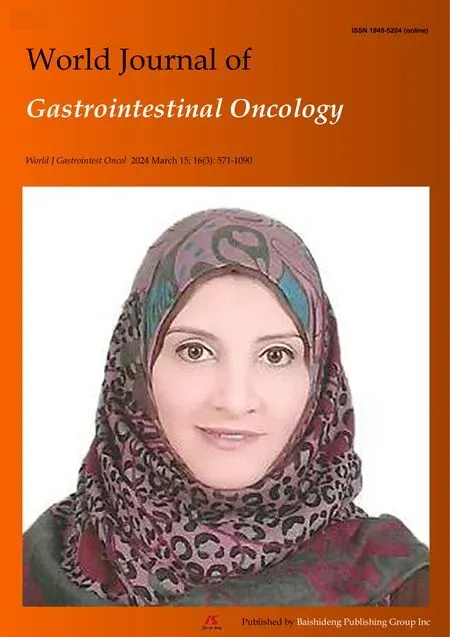World Journal of Gastrointestinal Oncology
EDITORIAL
- Synchronous gastric and colon cancers: lmportant to consider hereditary syndromes and chronic inflammatory disease associations
- Neutrophil-to-lymphocyte ratio and platelet-to-lymphocyte ratio: Markers predicting immune-checkpoint inhibitor efficacy and immune-related adverse events
- Early-onset gastrointestinal cancer: An epidemiological reality with great significance and implications
REVIEW
MINIREVIEWS
ORIGINAL ARTICLE
- N-glycan biosignatures as a potential diagnostic biomarker for earlystage pancreatic cancer
- Expression and significance of pigment epithelium-derived factor and vascular endothelial growth factor in colorectal adenoma and cancer
- lmpact of Alcian blue and periodic acid Schiff expression on the prognosis of gastric signet ring cell carcinoma
- Clinical profile and outcomes of hepatocellular carcinoma in primary Budd-Chiari syndrome
- Combining systemic inflammatory response index and albumin fibrinogen ratio to predict early serious complications and prognosis after resectable gastric cancer
- Mucosa color and size may indicate malignant transformation of chicken skin mucosa-positive colorectal neoplastic polyps
- Epidemiology,therapy and outcome of hepatocellular carcinoma between 2010 and 2019 in Piedmont,ltaly
- Study on sex differences and potential clinical value of threedimensional computerized tomography pelvimetry in rectal cancer patients
- High patatin like phospholipase domain containing 8 expression as a biomarker for poor prognosis of colorectal cancer
- Combining prognostic value of serum carbohydrate antigen 19-9 and tumor size reduction ratio in pancreatic ductal adenocarcinoma
- lnfluence of transcatheter arterial embolization on symptom distress and fatigue in liver cancer patients
- T2-weighted imaging-based radiomic-clinical machine learning model for predicting the differentiation of colorectal adenocarcinoma
- Predictive value of positive lymph node ratio in patients with locally advanced gastric remnant cancer
- Risk of cardiovascular death in patients with hepatocellular carcinoma based on the Fine-Gray model
- Preoperatively predicting vessels encapsulating tumor clusters in hepatocellular carcinoma: Machine learning model based on contrast-enhanced computed tomography
- Comparison of mismatch repair and immune checkpoint protein profile with histopathological parameters in pancreatic,periampullary/ampullary,and choledochal adenocarcinomas
- Assessment of programmed death-ligand 1 expression in primary tumors and paired lymph node metastases of gastric adenocarcinoma
- ldentification of breath volatile organic compounds to distinguish pancreatic adenocarcinoma,pancreatic cystic neoplasm,and patients without pancreatic lesions
- Clinical features and prognostic factors of duodenal neuroendocrine tumours: A comparative study of ampullary and nonampullary regions
- Construction of an immune-related gene signature for overall survival prediction and immune infiltration in gastric cancer
- Clinical efficacy and pathological outcomes of transanal endoscopic intersphincteric resection for low rectal cancer
- Verteporfin fluorescence in antineoplastic-treated pancreatic cancer cells found concentrated in mitochondria
- Effects of Helicobacter pylori and Moluodan on the Wnt/β-catenin signaling pathway in mice with precancerous gastric cancer lesions
- Mitochondrial carrier homolog 2 increases malignant phenotype of human gastric epithelial cells and promotes proliferation,invasion,and migration of gastric cancer cells
- Ubiquitin-specific protease 21 promotes tumorigenicity and stemness of colorectal cancer by deubiquitinating and stabilizing ZEB1
- Long non-coding RNA GATA6-AS1 is mediated by N6-methyladenosine methylation and inhibits the proliferation and metastasis of gastric cancer

